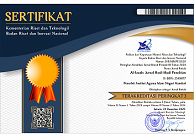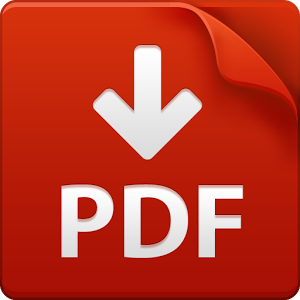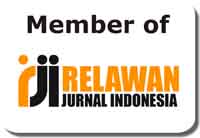Online Submissions
Already have a Username/Password for Al-Izzah: Jurnal Hasil-Hasil Penelitian?
Go to Login
Need a Username/Password?
Go to Registration
Registration and login are required to submit items online and to check the status of current submissions.
Author Guidelines
General Author Guidelines
- The written style of manuscript submitted to Jurnal Al-Izzah should be based on Non-IMRAD style consisting of (a) Introduction, (b) Finding and Discussion, (c) Conclusion, (d) Acknowledgement (if any), and e) Reference.
- Papers submitted should discuss the themes under social religious issues in Muslim society, especially in social and religious perspectives.
- Papers should be written either in Indonesian or English in single space, A4-paper size.
- Papers’ length is maximum 6,000 words including bibliography.
- All submissions should be accompanied by a brief abstract of no more than 200 words in English and of no more than 250 words in Indonesian.
- Full name(s) of the author(s) should appear without academic titles, along with the institutional affiliation(s) and email address(es).
- All submissions should be in Open Office, Microsoft Word, RTF, or WordPerfect document file format.
- Quotations and bibliographical references should appear at the foot of the relevant page and references follow Chicago Manual of Style 16th edition.
- Every source cited in the body of the article should appear in the reference, and all sources appearing in the reference should be cited in the body of the article.
- When a source is cited for the first time, full information is provided: full name(s) of author(s), title of the source in italic, place of publication, publishing company, date of publication, and the precise page that is cited. For the following citations of the same source, list the author’s last name, two or three words of the title, and the specific page number(s). The word ibid. may be used, but op. cit., and loc. cit. are not allowed.
- Foreign or local terms should be italicized.
12. Author(s) should proceed online submission via OJS application by login as author at “Register” menu. Submission guidelines could be found at the menu sidebar.
Manuscript Preparation Guidelines
- Title. The title should be brief and concise, indicating focus of the article. The title should not contain unfamiliar abbreviation.
- Author’s names and institutions. All authors’ names (the first, second, third, etc.) should be complete, without academic titles, along with the institutional affiliation(s) and email address(es).
- Abstract. One-paragraph abstract submitted should be both in English and Indonesian, containing the importance of the topic, aims of the study, method, findings, and around 3-6 keywords or phrases.
- Introduction. The introduction should consist of background of the study, research contexts, literary review (state of the art), and research objective written in systematic way. A two-to-three paragraph literary review in this part should critically discuss at least five of the most recent and updated relevant studies emphasizing on uniqueness or novelty of the study. Literary review should be presented in critical review of relevant study, highlighting the novelty of the study by indicating gap identification in the state of the art of the study. The introduction also covers brief presentation of focus, aims, and method of the study.
- Result and Discussion. The result and discussion section consist of description of result of data analysis to answer the research problem(s). Results of the study should be supported with data appropriate to its focus. Upon answering the research problem(s) and aims of the study, the result should scientifically address the following questions: (a) What are the results of the study? (b) How can this (or such phenomena) happen? (c) Why the trend is such as identified? All questions should be elaborated in a scientific fashion, not merely descriptive, supported with presentation of basic scientific phenomena.
- Conclusion. The conclusion section consists of the summary of the main findings presented in the form of paragraphs, not pointers. Conclusion summarizes the hypothesis and/or aims of the study. It is not restatement of findings and discussion, but more to summary of findings as expected in the aims or hypothesis of the study.
- References. Every source cited in the body of the article should appear in the reference, and all sources appearing in the reference should be cited in the body of the article. The reference list should be alphabetically and chronologically ordered. The sources cited are primary sources covering least 80% from those published in the last 10 years (except certain areas of study). Authors are recommended to use reference management application such as Mendeley, EndNote, Zotero using Chicago Manual of Style 16th edition with Times New Roman, font size 12.
Examples of footnote style:
1 Greg Fealy, Divided Majority: Limits of Indonesia Political Islam, 1st Edition, (London: Routledge, 2003), 123.
4 Ibid, p. 56
Example of Bibliography:
Moran Yarchi, Moran & Samuel-Azran, Tal. “Women Politicians are More Engaging: Male Versus Female Politicians’ Ability to Generate Users’ Engagement on Social Media during an Election Campaign.” Journal of Information, Communication & Society, 21 no. 7 (2018): 1-18.
Fealy, Greg. Divided Majority: Limits of Indonesia Political Islam, 1st Edition. London: Routledge, 2003.
The template of Author Guidelines in word document format is available for download here
Submission Preparation Checklist
As part of the submission process, authors are required to check off their submission's compliance with all of the following items, and submissions may be returned to authors that do not adhere to these guidelines.
- The submission has not been previously published, nor is it before another journal for consideration (or an explanation has been provided in Comments to the Editor).
- The submission file is in OpenOffice, Microsoft Word, RTF, or WordPerfect document file format.
- Where available, URLs for the references have been provided.
- The text is single-spaced; uses a 12-point font; employs italics, rather than underlining (except with URL addresses); and all illustrations, figures, and tables are placed within the text at the appropriate points, rather than at the end.
- The text adheres to the stylistic and bibliographic requirements outlined in the Author Guidelines, which is found in About the Journal.
- If submitting to a peer-reviewed section of the journal, the instructions in Ensuring a Blind Review have been followed.
Privacy Statement
The names and email addresses entered in this journal site will be used exclusively for the stated purposes of this journal and will not be made available for any other purpose or to any other party.











